On Wednesday, October 18, 2006, we leave Kalgoorlie and
drive south to Coolgardie where the Holland
Track starts.
For the ones interested in the history of the Holland Track,
here a short introduction to it:
In September 1892 gold was discovered in Fly Flat near
Coolgardie (some 560 km east of Perth), which generated a
gold rush.
A contemporary newspaper reported "In Perth and Fremantle
everyone seems to be either carrying tents, picks, shovels
and dishes, or otherwise preparing for the road." In
fact, local stores actually sold out of shovels as a steady
steam of men poured eastwards to the gold fields.
Few were experienced prospectors, most were just clerks,
shopkeepers, farmhands ... they went in drays, wagons, on
horseback, on foot, carrying swags or pushing wheelbarrows.
The streets of Albany were soon as well crowded with
fortune seekers who came by steamer from the eastern states.
Many of these "t'othersiders" continued on by
train on the recently completed Great Southern Railway
towards York or Northam, where they purchased supplies
and equipment
before tackling the long trail east to the gold fields.
As having a railway town closer to the gold fields was
becoming more and more important several attempts were
made to find new routes starting from several locations.
Many of the parties were forced back by the waterless and
impenetrable nature of the country. Some were never
heard of again.


Then John Holland, a local sandalwood haulier and
kangaroo shooter, had the idea to directly cut a final
track and use that track instantly to get supplies and
water to his men. He was joined by the brothers Rudolph
and David Krakouer and John Carmody, all local people too.
They left with five ponies, one hauling a dray with 100
gallons of water and their provisions.
Within days they were engage in hacking their path through
dense thickets. Each morning, Holland rode out alone, casting
up to 30 km ahead of the group in search of water. The
found supplies usually consisted of rockholes and soaks
at massive granite outcrops.
The party reached Gnarlbine Rock, close to Coolgardie,
two months and Four days after their departure in Broomhill.
Using the new track, travelling time between Broomhill
and Coolgardie was now about two weeks. As anticipated,
the track was immediately used by hundreds of eager diggers
joining the gold rush. The track was also used by horse
and camel teams transporting goods and supplies to the
goldfields.
However the extension of the railway from Northam to Coolgardie
just three years later put an end to the regular traffic
on the Holland Track.
The Holland Track was almost forgotten for several decades.
In the 1920s, parts of the route played an important part
in the opening up of wheat growing regions such as Pingrup,
Lake Biddy and Newdegate. Sections of the track were incorporated
into the rural road network. But the low rainfall out beyond
the Rabbit Proof Fence discouraged settlement. The northern
half of the Holland Track gradually returned to the wild
....
In the 1980s, attempts to retrace sections of the track were
made by several 4WD enthusiasts. In November 1992 the track
was opened up again with a tractor fitted with a timber
rake following a compass course. In some areas traces of
the old track were still visible. Despite the use of mechanised
equipment the people gained an insight into the magnitude
of the task achieved by Holland and his team.
In 1995 a map and small book was published encouraging
4Wdrivers to give the Holland Track a try.
Today the Holland Track is maintained by the Toyota Landcruiser
Club.
Thanks guys, you are doing a great job!
We will be travelling the Holland Track in two OKAs, our
OKA NT 01 and Peter and Margaret's OKA 196. Peter and Margaret
will also be towing a boat behind themselves, as they
are coming from Kalumburu (where they had stayed over winter)
and are on their way home to Adelaide. We are not sure, if
we will manage as the track width is really made for and
by Landcruisers, but we will see.
According to the weather forecast it will be sunny for
the next few days. This is good news as the Holland Track
is
well known of getting boggy with rain.
So we hit the dirt track shortly after Coolgardie and turn
south into Victoria Rock Road.
Soon after we reach the first highlight: Gnarlbine
Rock.



We explore the rock and find some interesting rock-formations.


It is also easy to see how nature is working on "blasting" large
sections of rock away.





Even though the soak at the bottom of Gnarlbine Rock is
dry and the day-temperatures are in the mid 30s the flowers
bloom in the crevice and around the rock.
We continue to Victoria Rocks Nature Reserve and
stay over night.




On Thursday morning we hike around Victoria Rock and the
ladies are busy taking pictures.



We also try to find the large Gnamma hole that is supposed
to be on the west side of the rock but only find puddles
of water (Gnamma holes are waterholes used by the Aboriginals,
usually covered by granite slabs to keep them clean and animals
out).
Ruedi and Peter decide to grease the OKAs, so Susi and Margaret
have lots of time to go for another look of the Gnamma holes
... and of course to take pictures of flowers!

The rocks are inhabited by lots of dragons. They are everywhere!
It is very funny to watch them moving as they erect themselves
on their back-feet to run away.
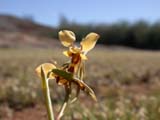


Amongst the many flowers Susi and Margaret also find a Donkey
Orchid.






We continue south and turn off towards the Pigeon Hole.
The track is very narrow. In addition the branches of the
trees lean into the track and are so low that both OKAs
have to take care that they don't rip down too many trees
and branches. Here it is obvious, that the track is not
made for trucks of the size of an OKA.
Still, the roof collects a fair bit of firewood ....

The water holed at the Pigeon Hole has fresh water but is
busily visited by a swarm of bees so we don't dare getting
too close to it.

A beautiful sunset is presented to the weary travellers
....






On Friday morning we reach an area of road where both sides
are covered with wildflowers.




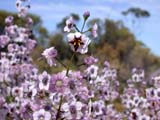
There are so many different colours, shapes and specialities
to be discovered ...
Susi and Margaret would stay for hours but the men get restless
....


We also find a blazed tree along the track.


Then we find a lot of ripe quadongs. We collect a hat full
and later that day they are turned into jam.
The jam tastes
quite nice, like rose hip, just a bit stronger.





The track is interesting and varied, sometimes even a bit
challenging and a lot of fun.





At Thursday Rock an interesting selection
of rocks can be viewed.




Again we try to find the soaks mentioned in the guide but
have no luck. All we find are puddles of water, some with
fascination decorations made by lichen.
With us as scouts poor John Holland and his crew would have
died of thirst out here!





Around a patch of high grass we find a selection of flowers,
paper daisies and ... the pink one could be an orchid, the
blue one a lobelia, but the flower book once again does not
help much with identifying.
We
can't blame them!
In Western
Australia there are well over 10'000 different wildflowers
species identified and thousands of new ones are awaiting
classification.



Last year large parts of the Holland Track had fallen victim
to bush-fires.
We are surprised to see that the sections where
recent bush-fires had gone through are the ones
where the
most
flowers
bloom.
But somehow it makes sense; there is less competition
for water with already established plants and bushed and there
is also more sunlight.



It is such a delight to drive through these tracks.
We continue on to Diamond Rock, where we
go for a walk.
It is incomprehensible how thoughtless people can be by
driving on the rock.
It crushes and destroys the rock and the marks
will be visible for many years.
This are the idiots responsable for future, else unnecessary
road closures and the like.
To prevent further damage CALM has erected barriers.


The next stop is at Agnes Gnamma Hole.
The
hole is located just beside the road and has good quality
water.
The Gnamma hole was named after John Holland's wife Agnes.
She was the first woman to travel the track when, aged
20, she accompanied John on his second trip to the goldfields
in December 1893.
She died of typhoid in May 1894, the
first
white woman to die in Coolgardie.
Agnes and John Holland are both buried in Coolgardie's'
Pioneer Cemetery.
We continue south, past Ewing Rock.
The track gets narrower and is overgrown.
The OKAs start
getting the "Holland Track look" ... green marks
along the sides from the shrubs and bushes ...

We reach Krakouer Rock (named after the
Krakouer brothers who accompanied John Holland) where we
stay for the night.
We enter our visit in the log book, being a glass where one
places a small piece of paper with the details of the visit
on it.
It is fun to check out who has recently been her and read
their comments.
During the night there is sheet lightning and a few drops
of rain fall.
On Saturday, October 21, we see showers of
rain falling north of us.
We wonder how the track will
be today.
As we continue south we sight a car coming towards us and
stop.
After having been alone on the track for 4 days the
men have a chat with the driver of the car to get detail
on
the track ahead of us ....






.... the ladies (including the one in the other car!) wander
off into the flowers ....






Being a sandy stretch of the track Susi and Margaret find
many new species they had not yet seen.


Shortly after we reach an area where there had been rain
last night.
The patterning on the road is amazing. We feel sorry to drive
over it as it means destroying it.



The course of the Holland Track has been changed in the
past because of the damages caused to the track.
But the new parts already show signs of deterioration; people
have already started driving around the damaged areas.
Because
of the widths of the OKAs we cannot drive around it but have
no problem driving through it.
The Holland track is known to be very boggy when wet. travelling
the track requires a few days. If one is hit by rain, he
has to decide if he may stay put or if he has to carry on.
If he continues driving on the soft track he of course generates
severe damage to the track.
We continue on to Centenary Rock.
Tourist information is broadcasted on the Holland Track on
FM at 100 MHz, Centenary Rock being one of the broadcasting
points. The transmitters are very weak and can only be
received around the touroistic spots. A very good idea.





We continue on the sandy track.
Here the bush-fires must
have passed through much faster, thus also being less destructive.
Nature has already recuperating, soon this track will be overgrown
again.
Another vehicle crossed .... this place is getting crowded!
Today being Saturday we must expect more traffic as 4WD-enthusiast
will hit the track for a bit of fun on the weekend.






We reach the State Barrier Fence where
we find some nice specimen of Featherflowers.
This 260 km fence, running down
from the No. 1 Rabbit Proof Fence northwards of the wheatbelt
town of Bonnie Rock, was built in 1954 to keep flocks
of
emu from
farmlands.
The fence ends at this remote spot because
work had to be stopped when the government run out of funds
.....


We drive through Jilbadji
Nature Reserve and reach Sandalwood Rocks.
When John Holland camped here there had been pockets of sandalwood
but not a single tree has survived the logging.
The visitors log at Sandalwood Rocks is a bit special too:
flat rocks are used to record the details of the visitors on
them.
The track gets narrow and has lots of curves. Luckily there is no oncoming
traffic!





We stop for the night in the vicinity of the Bounty Gold Mines.
A looming thunderstorm generates stunning colours in the
sky.
Just as we finish dinner the first few drops fall ..... just
enough to get us running for cover .... no more rain falls
after that.
On Sunday morning we continue on the track, that gets narrower
and narrower ...






... sometimes too narrow ...
When we removed this dead tree from the roof we did not realise
how close Peter has parked his OKA behind ours.
We miss
his roof by about 20 cm ....



We reach the Mallee Fowl's nest but find it to be deserted.
We cannot blame the bird for doing this; the road basically
goes around its nest!
Shortly after we have to hit the breaks.



A Thorny Devil (Moloch horridus) sits in the middle of the
track and challenges the OKA .....
It does not move, no matter
what we do .... beeping the horn (no wonder with the horn
the OKA has!!!!) ..... getting out of the car .... walking
around it ....
it just stands there and stares at the OKA.
Peter picks it up and places it on the side of the road,
just beside a reddish rock.
Fascinated we watch as the skin of the
Thorny Devil changes from the greenish touch it had on the
track to a more reddish touch, blending it into the landscape
perfectly.

As we are ready to continue travelling 3 cars arrive from
the opposite side.
They come over for a chat, expressing their disbelieve that
we actually got through a track that is made for Toyotas
and alike with the OKA.
Then they move their cars out of the way to let
our OKA through
(the rule is that the smaller one moves out of the way).
Their facial expression changes to disbelieve when Peter
and Margaret's OKA appears behind our OKA .... a second OKA,
and it's even towing a boat! ... and we get a good laugh
out of this.


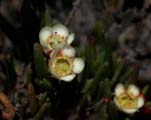

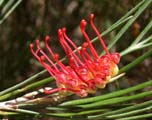
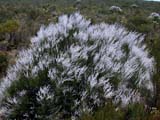
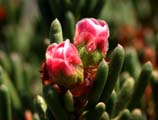
We pass some more stunning patches of flowers with Featherflowers,
Waxflowers, Clawflower,
Grevilleas, Smokebush
and then the wildflower guide fails again ....

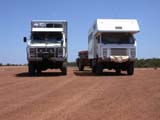


When we reach the Hyden - Norseman Road,
where the Holland Track ends, we decide to continue on into
the John Holland
Way.




Up to the vermin-proof State Barrier Fence the
track is fine and well maintained, after that it a different
story .... it really gets narrow.
The section just before
Emu Rock has not been driven for a long time and we do some
real "bush-bashing", plough our way through the
overgrown track, the branches hitting the windscreen.



The scrubland surrounding Emu Rock is
blooming in vivid yellow colours. Against the red soil it
is quite
a sight.
From here on the track again is well maintained.
It looks
like visitors to Emu Rock rarely come from the
north.



We continue on passed Modesty Rock to Lake
Carmody.


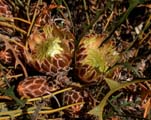


We seem to travel on tracks that are not used very often.
The rain has obliterated all tire-marks thus making it perfect
to display animal tracks.
Every day we seem to reach a new area of vegetation with
new species of flowers to be discovered.



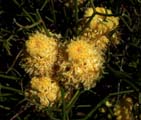
Some of the plants like the coneflowers only reveal their
secret once one gets a closer look.


We reach Dragon Rocks and are amazed how
well the tracks are preserved after more than 100 years!
We
decide to stay here for the night and after this hot
and muggy day with temperatures in the mid 30s enjoy the
well deserved
cold shandy.
Monday greats us with an overcast sky.




On our way further south we are once again surrounded
by a blooming country.







Featherflowers, Eucalyptus, Bottlebrush, and the Curly Grevillea
....



Not much is left of the Lake Biddy townsite.
The fridge,
today used as letter box, is occupied by a large Huntsman
and also a Redback Spider (we didn't dare get that close
to take a picture of the Redback ...)


We find a large watertank and fill the tanks of the vehicles.
Even though we enter our details in the provided book and
the
amount
of
water
we have taken (approx. 200 lt) we never get a bill.
Thanks to the water community at Lake Biddy!
At Silver Wattle Hill Nature Reserve we
have a look at some wheel ruts of the original
Holland Track
but
they are far less
distinctive than the ones at Dragon Rocks.





We reach Holland Tank and explore the water-catchment
system on Holland Rock.
The water falling on the surface of the large rock is collected
and directed to a pipe leading to the tank.
The tank has small leaks enabling the animals to have its share
of the water too.



We also investigate the various Gnamma holes on the rocky
surface.
They seem to be well maintained and the water in them is
clean.



Later on we reach the area of the Chinocup
Nature Reserve and its salt lakes and stop at
Lake Altham for
the night.
The temperatures are dropping slowly but surely with day-temperatures
in the high twenties and overnight-temperatures below 15°C.



On Tuesday it is windy, overcast and rather cool, but by
the time we reach Gnowangerup the weather
has improved again.



It is quite obvious that we have reached an agricultural
area.
And the tractors used in this farming community
for certain have changed a bit with time ....

Later on we reach the Stirling Ranges where
we find ourselves a spot for the night just outside of the Stirling
Ranges National Park.
As the park is famous for its flowers (especially its orchids),
the walks and the scenic drive we hope for good weather for
tomorrow.
A
bit of rain falls over night and the temperatures drop below
10°C. 

On Wednesday morning the weather has improved
and we decide to hike Bluff Knoll.
This
1'073 m high mountain is the only place in Western Australia
where every winter a few snowflakes fall.
The difference in altitude from the parking lot to the tip
is over 1'000 m.



The climb is pretty steep and we have to stop every
so often giving us the chance to enjoy the changing scenery.
More and more we leave the scrub behind us and start getting
a view of the country around us.



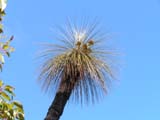
There is lots to be
enjoyed on the way up, from interesting caterpillars .....
to the drumsticks (Kingia australis) no, it's not a grasstree
(Xanthorrhoea preissii)!
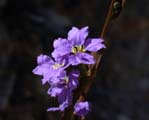



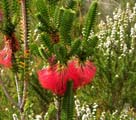
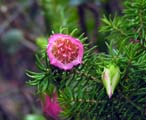

... to flowers ... Dampiera, Velleia, Red Pea, the stunning
Southern Cross, Bottlebrush, Darvinias ....



Every so often we have to sop and just enjoy the magnificent
views.





Reaching the summit we have lunch.
Peter spots a suspicious fire within
the National Park and call 000 on his Satellite-Phone cum
mobile-phone (depending on the location the phone detects
if it has to function as Satellite-phone or as mobile phone;
no matter in what mode it is used the charges to the
user are mobile-phone charges).
After being transferred twice his call is passed on to the
Department of Conservation and Land Management CALM in Perth.
Peter is informed that CALM is performing a controlled burning
and all is under control.
We are impressed.
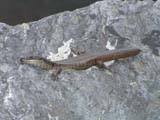

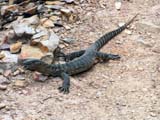

The mountain is populated with reptiles in all sizes.
The
Goana was at least 50 cm long and so used to people, that
it would not be bothered by us
at
all
and continued eating his ants.



On the way back to our camping spot we stop at Paper
Collar Creek, famous
for its orchids. Susi and Margaret virtually stumble over
a Leopard
Orchid,
many Common Mignonettes, and some kind of Spider (or Bee?)
Orchid ...
On Thursday, after another cold night with only 8.9°C
it is overcast and a cold wind is blowing.


Still we decide to drive along the scenic drive and are
rewarded with an abundance of flowers .....






... Mallee, Dryandra, Banksia with its fancy curling leaves,
Hakeas, Starflowers ....




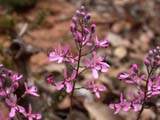
... Triggerplants ... 





... Peas ... 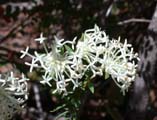


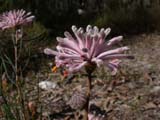


.... Banjines, Coneflowers, Grevilleas ...







... Leschenaultias, Dampieras, Sundews....





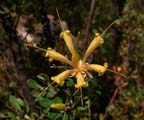
... Cottonheads, Chittik, Honeysuckle ...
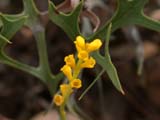

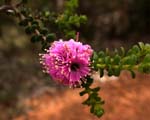
... Synaphea, Leschenaultia, Kunzea ...





.... and many more unknown ones.



As we drive along a small track the roadside suddenly looks
like of it is burning .... what a sight!




Then we get challenged by a Shingelback (a kind of blue
thong lizard).
They are amazing little critters.
If they get attacked, they form the body to an U-shape, turn
their back legs around so for the enemy
it looks like
it actually
facing
two animals.
It gets really
angry and attacks Peter's shoe. It's a fierce little
thing!
Click here  to view the movie. to view the movie.

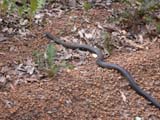
We also find this Brown Snake or Dugite [Pseudonaja affinis]
and once again are reminded that just because we don't see
them all the time, it doesn't mean that there are no snakes
around!
We pass through Cranbrook and turn into
Boyup Brook Road.
The road is a Mecca for flower-lovers
(The computer-administrator slowely goes bunkers, but our internet
provider loves them too and most certainly will send us a
increased bill due to our rising disk space requirements)
.....



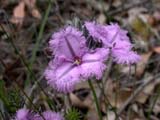

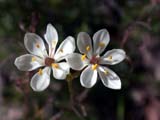
... Kangaroo Pows, Basket Flowers, Patersonias, Fringe Lily,
Westringia, Milkmaids ...


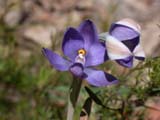
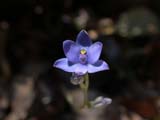
.. and the orchids ..... Cowslip, Spider, Scented Sun, Blue
Lady ....



... and some unknown beauties.
When we pass a deserted property with an old house on it
near Palgarup State Park we decide to stay for the night.
On Friday, October 27, we visit Roo Gully (www.roogully.com
).





This is a kangaroo sanctuary that became famous through
a series on ABC TV we also watched during the first half
of 2006.
Carol, who runs the place, takes her time to show us around.



The babies are so cute! Ruedi looks kind of lost .... it
is very obvious he never had kids!
We continue north through the large forests of the Wilga
State Forest, where pine trees are farmed.
We stay for the night near Lake Ngartiminny.
On Saturday morning we head north.
Today we are expected
near Beverly, on the property of Robert and Cherry Williamson
,
fellow OKA-owners.




They want to build an OKA-camper but are still in the planning
phase.
Having OKA 196 and our OKA there gives them a whole new way
of looking at it.
While the men are OKA-ing again, looking at axles and technical
solutions, the ladies have a little party in the kitchen.



As the night closes in the men join the party ....
On Sunday Robert and Cherry take their time to show us their
station.




They haven't had decent rains this year and all is dry and
yellow.




There is still water in the dam but Robert is feeding the
sheep with grain, which is unusual for this time of
the year.

We have a bit of fun at the creek where Robert shows us
the abilities of his OKA.
One proud OKA-owner talking to other proud OKA-owners ....
On Monday it's the last day of the sheep-sheering.



Margaret and Peter both have experience with this, but for
us it is great.
Click here  to view the movie. to view the movie.

Out in the paddock Susi finds several small pieces of fur
and curiously asks what it is. 



Well, it is the "left-over" from young sheep prevented
of becoming rams .....
Applying this rubber ring cuts the blood off and eventually
the dead part falls off.
Good to know, that
it doesn't hurt them.





Cherry then explains some of the tools they use ....
- the tool to squirt medicine down the sheep's thought
- the tool to crop the sheep's tails
- special animal-safe colour spray to mark the animals
- the paperwork required to move sheep around
It's really interesting to get such an insight into this side
of running a station.
We just love it!
Later on Ruedi checks something on the OKA.
When switching the diesel tanks
suddently all electronically controlled instruments go
blank. Ruedi cannot get them back to work.
As we are just 100 km out of Perth an anyway on the way
to OKA for the service he does not really bother checking
for
the
reason.
Having just changed the diesel tank to the full one it
does not matter if the diesel indicator does not function
and he uses the GPS for speed-indication, so not having
the speedometer does not bother him either.
Soon we are all again in the kitchen and the party continues.
Everybody has stories to tell and there is lots of laughter
and fun.
On Tuesday Robert takes a day off and shows us the surroundings.
We drive to the Beverly gliding field, where Peter and Margaret,
both being glider pilots, find some known planes.
Later on we find out that one of Ruedi's ex-bosses in Switzerland
in 1993 was member of the Beverly Glider Club for one
month to be able to compete in a competition.
The world is so small at times .....




We also visit York and its surroundings.
Then it's back to the station and some more partying .....
On Wednesday, November 1, we have to leave, Perth is calling!
Dear Robert and Cherry,
Thank you so much for your hospitality.
We had a great time!



Shortly before reaching Roleystone and the steep decent
to Armadale the red warning light comes on announcing an
auto shut-off of the engine.
This would
mean no power breaks, no power
steering .... all just before a fairly steep descent .....
stress sets in ....
Ruedi
asks Susi to warn Peter on the UHF that we have a serious
malfunction.
As we are being passed by a road train at the same time Ruedi
has to concentrate on keeping the truck on the road.
Either Peter doesn't understand Susi or he is too
close to the truck and is not able to react because of the
boat
he is towing, anyway, he also passes us.
Then Ruedi pulls the OKA to the other side
of the road and up the embankment to stop it.
After a first seconds to catch breath again Ruedi and Peter
start checking possible reasons for this auto-shut-off.
As the instruments are not working they cannot find the cause
and Ruedi calls Linden,
the engineer at OKA, to discuss what should
be done.
So the driver-cabin is cleared out and the engine inspected
... no success.
All the fuses are checked ... all are fine .....
.... but as he removes and reinserts one of the least logical
fuses ....
ah,
the
instruments
have a reading again.
Most likely the speedo, which holds the programm of all the
instruments, had a glitch and Ruedi had to completely remove
the power
to
reset
the
circuit.
When checking the instruments Ruedi detects that the tank
indicator shows 0% diesel.
That is weird
as he had changed the tanks over just before the
instruments went blank.
Now it is clear what happened:
because yesterday's failure had happened exactly when Ruedi
was switching the
tanks,
the tanks had not really been switched .... so we had driven
on an almost empty tank.
When the tank was empty logically the engine had shut down.
All makes sense now except .... what made the instruments
to stop....?
Well, that will be something for Linden and the team at OKA.





During the failure Susi and Margaret have lots of time
to have another look at the flowers.


At OKA the truck quickly becomes the central point of attention.
Figures, it is still the only one of the new NT-series that
is on the road and the engineers have an opportunity to check
how their "baby" has been doing on its travels
.....
|

![]() Created by Level X Webdesign
Created by Level X Webdesign